#Buddhist Cremation
Explore tagged Tumblr posts
Text
Everything You Should Know About the Professional Hindu Funeral Service London
Death is the ultimate truth, and no one can escape its claws. However, families have to perform funeral rituals when someone dies in their family. Though this is the most painful moment, as relatives, it is our duty to maintain such piousness. With a professional Hindu funeral service in London, the task becomes easier. Here is all about the Hindu funeral service.
Hindu Death Rituals

Hinduism believes in reincarnation. It means that once the death happens, the sound of the person leaves the body and never returns to it; however, it travels to another body, which is known as the birth of a baby. This is the reason the dead body gets burned at the crematorium. Since the process is complex and there are certain rituals that have to be followed in different beliefs, it is important to know the exact death rituals in Hinduism.
Washing- The ritual starts by washing the body with several ingredients like milk, honey, yogurt, and ghee.
Applying Essential Oils- Applying essential oils is another part of the ritual. Sandalwood mainly applied for men and turmeric for women.
Dressing- No dead body left naked till it is on the fire. A simple white cloth sheet is worn to the person who has died. There are some stylish and pricy clothes are also used to perform this ritual.
Flowers and Rice- In some funeral process, the attendees are allowed to place a garland of flowers and rice balls around the loved once. Several leaves like basil also used to adorn the body.
Lighting Lamp- Lamp is important to place near the head as it signifies the purity and assists the safe journey of the soul.
Sprinkling Water- Sprinkling water on the body is a symbol of cleansing the dead body, and it is part of the ritual.
Conducting Hindu Cremation Process
According to the scriptures, the cremation should be done as soon as possible. It is ideal to take place within the first day. Meanwhile, friends and family come to the home to offer their last respects, and then the cremation process starts.
While carrying the body to the crematorium, it is important to bring the body from the side of the feet. Priests and mourners recite hymns that are believed to make the path of liberation easier for the deceased person.
Hindu funeral is complex and there are a number of rituals to follow. Asian Funeral Services offers professional Hindu funeral service London that can mitigate the hassle of funeral of your loved one. Avail of this service to simplify the process!
Resource: https://asianfuneral.wordpress.com/2024/06/22/everything-you-should-know-about-the-professional-hindu-funeral-service-london/
#Asian Funerals in Wimbledon#Asian Funeral Services#Hindu Funeral Wandsworth#Tamil Funeral Service London#Indian Funeral Service in Wandsworth#Tamil funeral directors Uxbridge#Tamil funeral services in Wimbledon#Hindu Funeral Tooting#Tamil funeral services in Kingston#Tamil funeral services in Merton Park#Tamil Funeral Service Kenton#Tamil funeral services in Mitcham#Hindu Funeral in South London#Om funeralservices#Tamil funeral services in Morden#Tamil funeral services in Streatham#Tamil funeral services in Croydon#Indian Cremation Services South London#Islamic Burial London prices#Tamil funeral services in Sutton#Asian Funeral Service London#Tamil Funeral in Tooting#Hindu Funeral Service London#Hindu Funeral Directors near me#Indian funeral directors near me#Nepalese funeral services#Buddhist Cremation Service#Buddhist Cremation#Jain funeral service Borehamwood#Swaminarayan funeral services
0 notes
Text

Buddhist cremation in Burma, modern-day Myanmar
British vintage postcard
#cremation#british#postal#burma#vintage#postkaart#myanmar#ansichtskarte#photo#tarjeta#ephemera#sepia#postkarte#carte postale#briefkaart#modern#photography#postcard#buddhist#historic
3 notes
·
View notes
Text
Why Yuuji’s domain is a manifestation of his desire to save Megumi:
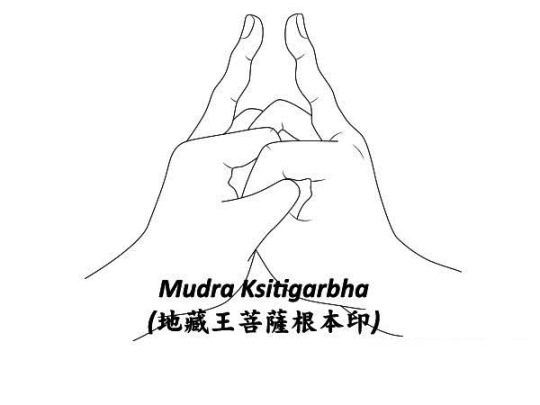
The hand symbol he used to open his domain is similar to the Mudra associated with Bodhisattva Kṣitigarbha, who is known as Bodhisattva Jizō (地蔵) in Japanese Buddhism.
In the common Japanese tradition, Bodhisattva Jizō is portrayed as the protector of the souls of children, who are condemned to stack piles of stones vainly on the banks of the Sanzu River (a mythological river in Japanese Buddhist tradition that one must cross to reach the afterlife), as these towers are repeatedly toppled. The legend has various versions. In one of the versions, the oni (demons) wreck the stone piles and torment the children, and the children seek haven with Bodhisattva Jizō who hides them inside his garment and comforts them. In another version, when the children pile stones at the 'Children’s Riverbed Hell', winds and flames are the agents knocking down the stone tower, and the flames reduce the children into cremated bones, to be revived back to whole by Bodhisattva Jizō.
It would not be an exaggeration to draw a comparison between the legend and the dynamic between Yuuji, Megumi and Sukuna: Megumi is one of those children at the riverbank, subjected to endless torment; Sukuna is the demon, the source of his torment; and Yuuji is the Bodhisattva, who has vowed to free those children from their torment, even at the cost of his own liberation (i.e. achieving Buddhahood).
We know that Domain Expansion is achieved by expanding one’s innate domain with cursed energy while using a barrier to construct it inside a separate space and that innate domain reflects one’s mind and soul. Saving Megumi has been Yuuji’s sole driving force, therefore it would not be an exaggeration either to assume that how he manifested his domain (i.e. the hand symbol for expanding it) is a reflection of his desire to save Megumi.
#there are also a lot of parallels (connections) that could be drawn between yuuji and sukuna through such association with jizō...#particularly when it comes to sukuna's past and his consuming his twin in the womb.#i might write on that later.#but i would recommend looking into it.#jjk spoilers#itadori yuuji#fushiguro megumi#itafushi#fushiita#jujutsu kaisen spoilers#sukuna
211 notes
·
View notes
Note
What do the names of your favorites mean?
You do realize that I have to understand Japanese kanji for this, right?
I can't even speak English or my own native language very well... and I'm supposed to be able to do this?
Okay, I'll try, but it might be a minor disaster. If anyone knows about the topic and finds a mistake, please correct me.

Contents
Dabi - Touya Todoroki
Hawks - Keigo Takami
Tomura Shigaraki - Tenko Shimura
Bonus - my OC Kaji Black

First, what is the Kanji?
Kanji is one of the three writing systems of the Japanese language – and arguably the oldest, most profound, and most symbolic of them. Originally adopted from Chinese, kanji consists of logographic characters – meaning that each one represents not just a sound or syllable, but carries meaning, often multiple meanings, depending on the context and combination.
You can imagine a kanji as a small image, a symbol that expresses an idea, a state, or a concrete thing. Some are very simple, like 木 (ki, "tree"), others are complex, like 鬱 (utsu, "depression" or "melancholy"), that gives you a headache just by looking at it.

Dabi (荼毘) – Tōuya Todoroki (轟燈矢)

Let's start with Dabi (荼毘)
The villain name of our beloved pyromaniac is a very good example of how versatile Kanji can be. How a single character takes on a completely new meaning when a second character is added.
荼 (Da) This kanji originally means “bitter herbs,” but in the Buddhist context it often refers to funeral rites, purification by fire, or the bitter taste of death.
毘 (Bi) means “help,” “protection,” but in combination with the first letter can also mean cremation – as in the word “荼毘 (Dabi)” itself, which actually means cremation in classical written language.
Tōuya Todoroki (轟燈矢)
From here on, it became clear to me that Kōhei Horikoshi had really put a lot of thought into the names of his characters. The meaning of the names partly reflects their quirks and stories.
Todoroki (轟) This kanji means "thunder" or "roaring sound" – a powerful, loud presence. It often stands as a symbol of strength, or something impossible to ignore – unmistakable and powerful.
Tōuya (燈矢)
燈 (Tō) means "lamp," "light," or "torch" – something that shines in the darkness and often symbolizes hope or memory.
矢 (Ya) means "arrow" – something straight, fast, and directed.
In summary, Tōuya Todoroki can be poetically interpreted as “bright arrow of thunder” or “torch arrow that passes through the thunder”.

Hawks – Keigo Takami (鷹見啓悟)

Our beloved red-feathered hero Hawks.
That's kind of ironic. Hawks had kept his real name secret for a long time, but he uses part of his surname as the name of his heroname – just in a different language.
Takami (鷹見)
Taka (鷹) means "falcon" – a bird of prey known for its speed, vision, and elegance.
Mi (見) means "to see," "to observe," literally "hawk vision" or "one who sees like a hawk."
Keigo (啓悟)
啓 (Kei) means "to reveal," "to explain," "to illuminate"—it is a symbol of insight, clarity, and sometimes a kind of guide.
悟 (Go) means "understanding," "awakening," or "spiritual understanding"—a deep, inner knowing.
In summary, Keigo Takami could mean “the enlightened falcon who sees with clear vision” or “the seeing, understanding falcon”.

Tomura Shigaraki (死柄木弔)
Tenko Shimura (志村転弧)

This will be very interesting.
Both names have great significance for the series and the manga. In my opinion, it reflects him perfectly.
Shigaraki (死柄木)
死 (Shi) means "death."
柄 (Gara) can mean "handle," "style," or even "pattern," and sometimes symbolizes character traits or external characteristics.
木 (Ki) means "tree" or "wood."
In summary, Shigaraki can be interpreted very loosely as “grasp of death”, “deadly trunk” or “wood of death”.
In addition, “Shigaraki” is also a real place in Japan known for ancient ceramics.
Tomura (弔)
(弔) Tomura is only one kanji, which is rather rare in Japanese, since many first names consist of two characters. It means "to mourn," "to grieve for someone," "to honor a deceased person." It is the act of silent lament, of remembrance, of pain over loss.
When you put the two together, you get a hauntingly beautiful, symbolic meaning: Tomura Shigaraki – “He who mourns death” or “Mourner from the wood of death.”
Shimura (志村)
志 (Shi) means “will,” “intention,” or “striving” – a sign of determination, of ideals deeply rooted in the heart.
村 (Mura) simply means "village." Shimura can be interpreted as a "village of will" or as a symbol of a family united by its ideals.
Tenko (転弧)
転 (Ten) means “to turn”, “to tilt”, “to change” – a Kanji of movement, change, sometimes also of destabilization
弧 (Ko) denotes an “arc” – both geometrically and symbolically, such as the course of a path, of a destiny that is not straight but curved, as if pulled by forces that cannot be escaped.
Tenko could therefore be interpreted as “the curved change” or “the upheaval on a curved path”.
Tenko Shimura – "The Change from the Village of Will" or "The Crooked Will, Born of Hope, Twisted by Pain."

Kaji (火児) Black
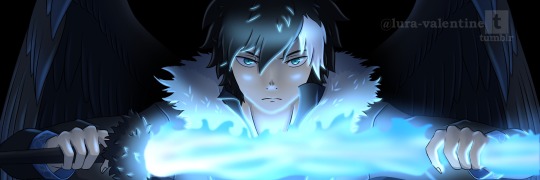
My OC Kaji, Dabi's son.
He was my first contact with the Kanji. Because of his background, I wanted a Japanese first name, while his last name is from Western countries. His mother has the surname Black and comes from Europe.
Kaji (火児)
火 (Ka) – the classic kanji for fire itself, not the fire, not the event, but the element, the essence – pure, powerful, ancient.
児 (Ji) – means child, offspring, sometimes even "little boy" in general. It has something innocent, something tender, almost contradicting the wildness of the first character.
His name means "child of fire," or more poetically: "the fireborn," "child of flames," "the boy born of embers."
And now comes my own paradox, which I just noticed... I actually chose the name Black because his mother has black wings and I thought it just fit.
Considering the meaning of “black,” the color, and everything that comes with it, like darkness or night, the name Kaji Black means what I imagined – “the child of fire, surrounded by darkness” or “The fire child who stands in the shadows.”

My moral supporters
@tiny-roki-todoroki | @alexandhisstuff | @doumadono | @unhinged-bratty-boy | @within-eyesight | @hiding-inner-dabi
@andrea-tries-to-write
I mention accounts that my works ❤️ and 🔄. If anyone no longer wishes to be mentioned, please let me know.
#bnha#mha#my hero academia#boku no hero academia#dabi#bnha dabi#mha dabi#touya todoroki#todoroki touya#tomura shiragaki#shigaraki tomura#shigaraki#mha hawks#bnha hawks#keigo takami#takami keigo#kaji black oc
33 notes
·
View notes
Text
Thinking about my Buddhist coworker saying that when she told her Catholic husband she wants to be cremated instead of buried he said 'but how will I find you 🥺' and she said 'idk'
60 notes
·
View notes
Text

Vessel with Knobbed Lid, Korea, Unified Silla period( 676-935). Stoneware.
This type of lidded vessel served to contain cremated remains, indicating the popularity of Buddhist mortuary practice in Korea during the Three Kingdoms period.
This storage vessel is distinguished by its robust, subtly proportioned form and its body color. The purplish-brown surface "skin" is enlivened by a series of smoky black swirling marks that occurred during the firing in the wood kiln. This shape began as a series of clay coils that were pinched and then paddled; however, it spent more time on a potter's wheel to thin and finish its outer surface. The lid received similar, understated attention to detailing and finish.
Courtesy Alain Truong
15 notes
·
View notes
Text
A very kind reminder: no matter how accessible to western audiences KinnPorsche The Series is, we have to keep in mind that these characters are Thai, with a very different background and culture than most of us western fans.
Porsche's parents may have a grave in the show, but it is more common to cremate the dead in Thailand. Tawan is a metaphorical, as well as literal, hungry ghost, which isn't the same as the kind of ghosts we believe in the West. Vegas might embody the aesthetic of a Catholic with his Mary skull statue and general vibe, but he is very much a Buddhist. The show in general is full of Buddhism imagery, and it includes not one but three scenes in which characters are making merit. The VegasPete temple scene in particular carries a lot of significance for their arc, and the kruat nam ceremony is the main reason for that.
Pete is the most prominent example when it comes to this. He's a Buddhist and from the countryside; his pha khao ma and his preference for spicy food is proof enough. His whole personality and background is shaped around these two facts. His view of the world, his personhood, his actions, his motives, his feelings, his opinions, all of that and more are influenced by it.
I'm not saying it's easy to understand when you're unfamiliar with another culture that's so different from your own. God knows I'm a novice when it comes to this - I'm sure I've made mistakes in meta and fics in the past.
(I know of a certain one that's bugging me for years, but correcting it would mean changing its entire ending scene and I prefer to leave it flawed as it is.)
It's just a nudge to fans to think a little bit more before making statements about characters and shows that represent an entire culture that isn't their own, and that, of course, goes to myself too.
#let's try to be more respectful of other cultures while engaging in fandom#it's the least we can do#and I apologize in advance if I've fucked up in that regard in any way shape or form#kinnporche the series#yu speaks
8 notes
·
View notes
Text



My friend asked me to draw them on their wedding day (bc I drew Chintan and Jamil).
Some oc ranting for my own comfort.. Their names are Lihay and Panganoron. In my wip, there is a dominion called Sasaban.. and its in danger of occupation by its neighbor (called Janalila, which is a rajahnate and extremely powerful.). Sasaban's population is mostly coded Muslim.. and it is a sultanate- Panganoron is the heir, their crown prince under a regent, and he is mostly shunned by his people. Mainly because he follows a different religion from his state religion (like imagine if the sultan of Brunei's son was a Buddhist.) . And Panganoron is seen as "weak".. he is very gentle, soft-spoken, academia inclined rather than cunning and war-like as the rest of his predecessors. (His father followed the state religion, his mother was indigenous). Panganoron is keen on proving himself worthy of being sultan, but he had a tendency of being distracted by socioeconomics rather than warding off forces and marching off into the battlefronts- Panganoron built soup kitchens and schools rather than amassing armies, and he is staunchly anti war and anti caste systems- but because of the looming occupation, Panganoron has no real power or resources to challenge the harmful pre-existing hierarchies in Sasaban. Anyways. Panganoron was offered a way out of war with the neighboring country of Janalila, if he married a princess from a different dominion- a theocracy called Kalantiaw, the oldest and the most noble dominion in their world; The princess' name was Maitreyi. If he married her, not even Janalila would dare make enemies of Sasaban and Kalantiaw both.
Panganoron was game, but since all the borders and ports were tightly guarded, Panganoron would have to make his way to Kalantiaw in disguise, with a skeleton crew, and through old , forgotten passageways, and roads that are called "witherways", magical, and only existing within certain, precisely calculated timeframes, of which only certain groups of indigenous people could do.
Lihay is. Well. He is an "uripon"- the lowest of the low in their social classes- indentured to servitude for the rest of his life, very sick from working in the mines.. in my world building, primordial dragons were so large, their hollowed out bones were mined for thousands and thousands of years for coal that burned for decades, so hot it could cremate a cadaver in minutes- working in such mines was very dangerous- guaranteed anyone who spent more than a couple of hours in it would suffer a tamer version of radiation poisoning- but many miners become disfigured, with their skin melting and rotting. Sasaban deals with this by only making lepers and the lowliest uripon mine- Lihay had lived all his life in the dragon-mines, but he was also indigenous- and he knew his way around the witherways.. so.
Lihay is very shy. He is trans, autistic and mute, and he has an enormous crush on Panganoron; Lihay agrees to be their guide, in exchange for his freedom from the mines, freedom from being an uripon, to a maharlika (freeman, I borrowed it from tagalog for my worldbuilding. In the real world, Timawa would be more appropriate)..
Either way. Lihay and Panganoron, traveling together with Panganoron's small entourage, fall in love, which is Very Bad for Panganoron, when the fate of his kingdom rely on him marrying Maitreyi of Kalantiaw- and Very Very Bad when the person he falls in love with is someone like Lihay.
Btw, Panganoron's name means "the clouds that gather at the mountaintop" in Tagalog. (And Bicol), while Lihay's name (Dalihayang) is from a made up language, and it means "twenty four.). But later, Panganoron gives him the name "Hininwon", which means "cherished one" ! ! :')
Ps ps.
Panganoron's eyes are supposed to look like wayang kulit akdksk
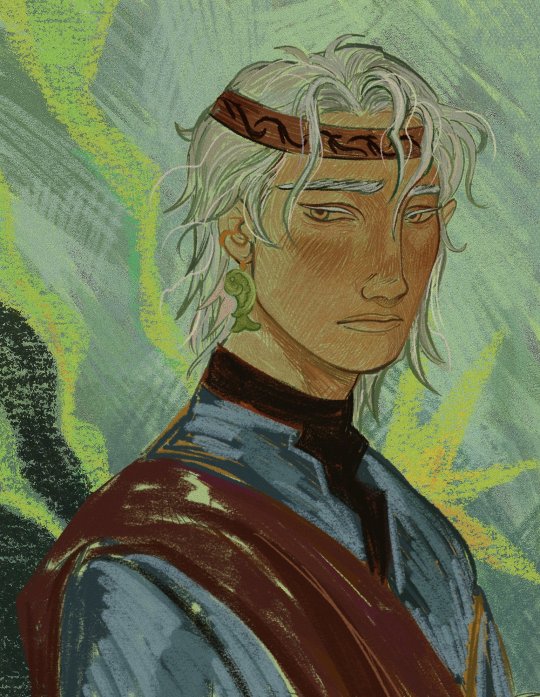

212 notes
·
View notes
Text
Discover compassionate Indian funeral directors near me, offering understanding and support during challenging times. We are committed to honoring cultural traditions and delivering personalized services that reflect the unique customs of the Indian community. Contact us today! For more information, you can call us at 020 8909 3737 or 07737 051232.
#Asian Funerals in Wimbledon#Asian Funeral Services#Hindu Funeral Wandsworth#Tamil Funeral Service London#Indian Funeral Service in Wandsworth#Tamil funeral directors Uxbridge#Tamil funeral services in Wimbledon#Hindu Funeral Tooting#Tamil funeral services in Kingston#Tamil funeral services in Merton Park#Tamil Funeral Service Kenton#Tamil funeral services in Mitcham#Hindu Funeral in South London#Om funeralservices#Tamil funeral services in Morden#Tamil funeral services in Streatham#Tamil funeral services in Croydon#Indian Cremation Services South London#Islamic Burial London prices#Tamil funeral services in Sutton#Asian Funeral Service London#Tamil Funeral in Tooting#Hindu Funeral Service London#Hindu Funeral Directors near me#Indian funeral directors near me#Nepalese funeral services#Buddhist Cremation Service#Buddhist Cremation#Jain funeral service Borehamwood#Swaminarayan funeral services
0 notes
Text
American WASP-ism and why the writer's table should have more risktakers
Let me add some spice to your day by talking about how, I really thought how 8x14 was written, that RAVI was going to be the Big Death, and would have officially fucked buck up as a leader ala Chimney feeling guilty about Kevin.
And let me tell you, as a desi Indian person, Indian Hindu funerals are so........ different(tm) lol.
Let me share some fun thoughts about those!
Most Hindu communities cremate the bodies, don't bury them. Some communities even go SPECIFICALLY to crematoriums where the body is placed on wood, and burnt that way (AKA LITERALLY BURNT ON WOOD). Imagine FIREFIGHTER BUCKLEY LEARNING this.
Again, depending on which community you belong to. Still, some superstions make people get rid of almost every personal belonging of the diseased person - some say that the more you hold on to it, the more the soul wants to stay, others say that after the official 13 days of mourning, the person becomes an ancestor and therefore must not be called upon, AKA Ravi as a person seized to exist. After 13 days he is an ancestor, not Ravi.
So we agree that Buck and Maddie have trauma with water, right? Guess what Hindu communities do with the ashes. They are not stored, or displayed. Either they are immersed in one of the three big seas, or one of the two major rivers. Again the idea is that the soul is eternal (but not in a christian way, more in The Good Place you collect points on earth, enjoy kinda heaven and REALLY hell, and return back to earth for trial no. 1111111 way). You literally cannot hold on to the ashes, that means the person will be stuck.
4. To give context to how old India is -In parts of India, especially in some Hindu, Buddhist, and tribal traditions, coins are placed on or near the body, sometimes on the eyes or chest or as part of funeral offerings.
#911#meta#I am fucked up xD#But seriously#Did I want Ravi to die? NO#But fucking up Buck is one of my favourite passtimes so#I Just had this WILD thought of the actual mechanics of a funeral ok#someone LITERALLY uses a piece of wood covered in cotton dipped in ghee and BURNS THE BODY#Imagine a bunch of firefighters learning that#IMAGINE#it's not clean metal box enter ashes exit#The entire thing is SO SO SO SO SO different than a christian funeral#or a pomp and circumstance funeral#so many things happen physically with the body#and it's SO DIFFERENT#911 abc#911 spoilers#evan buckley#ravi pannikar#anirudh pisharody#Also I have no idea where pisharody is from - it SOUNDS north indian but Anirudh has a lot of south indian features but IDK MAN WHO CARES#also ask me what oppari is#PLEASE SOMEONE ASK ME WHAT OPPARI IS#tw: death#tw: graphic details#tw: funerals#I guess?
11 notes
·
View notes
Text
Traditional Symbolism in Jujutsu Kaisen Opening 4 - Specialz

[⚠️Warning: Possible small spoilers⚠️]
Hata-jirushi (旗印)
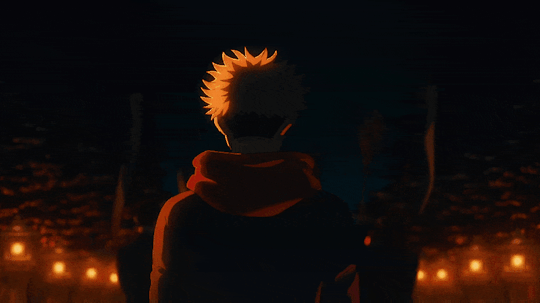
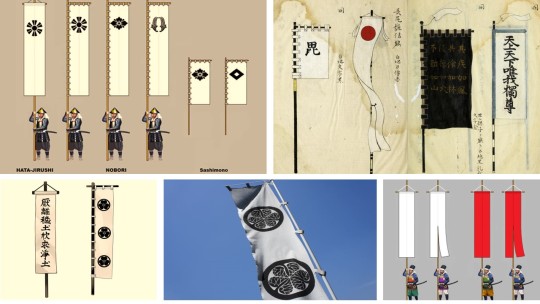
The white banners seen in the background of this scene are most likely Hata-jirushi (旗印). Hata-jirushi were the most commonly used war banners on medieval Japanese battlefields. The kanji used here “旗印” literally translates to “symbol flag”, “marker banner”, etc.… These war banners were generally simple streamers attached by a horizontal cross-piece to a shaft, unlike the later used nobori (幟) which were stiffened. Later, some hata-jirushi were hemmed on their sides and tops to better attach them to their poles in such a way that they were visible from the front. The purpose of these banners was to help identify and distinguish different army sections and regiments. The use of them in this scene helps to set the tone of this arc which is essentially the start of a war between jujutsu sorcerers and cursed spirits.
Torii (鳥居)

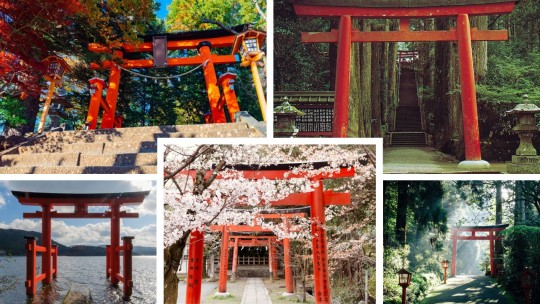
In this panel, several characters are seen passing through a torii (鳥居). A torii is a traditional Japanese gate mostly found at the entrance of and within Shinto shrines. Torii gates are where kami are thought to travel through and are welcomed to the shrine. It is customary to walk to the side of a torii gate when passing through instead of walking down the center—as it is believed that only kami may pass through the center. The word torii derives from the term “tōri-iru” (通り入る) which roughly translates to “pass through and enter”. These structures mark the transition between the mundane, secular world and the sacred grounds of the shrine. Thus, passing through a torii gate can be thought of as “crossing into another dimension or entering into spiritual communion with nature”. Torii gates act as both a physical barrier and spiritual guardian separating the profane from the sacred within its boundaries. Therefore, it is believed that those who pass through one, are cleansed of their worldly worries and enter a realm of tranquillity and peace. Aside from their religious significance, torii gates hold other more abstract meanings such as providing good fortune, hope, purity, and protection from evil spirits. In this panel, as the characters pass underneath the torii it signifies their crossing from the physical to the spiritual world—which could refer to them traveling down the path to enlightenment or death. Since torii are also believed to provide good fortune and protection from evil spirits, the characters passing under one could be a sort of send-off ritual before the battle to ensure their safety.
Ōnusa (大幣)
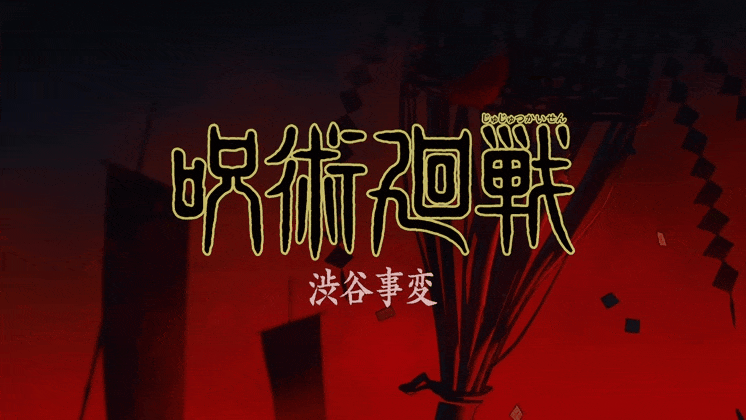
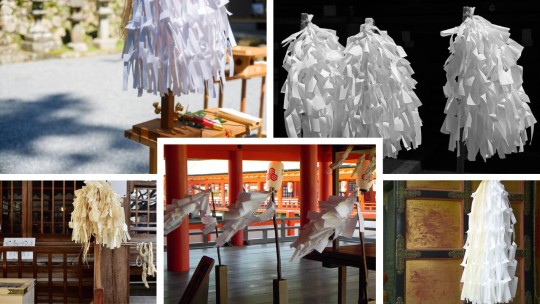
In addition to more hata-jirushi, we can see an ōnusa (大幣)—also known as a nusa (幣) or a Taima (大幣)—a wooden wand used in traditional Shinto purification rituals in this panel. Ōnusa are embellished with shide (paper streamers). The wand is also referred to as a (祓串) when the shide are connected to a hexagonal or octagonal staff. It is believed that impurities are transferred from the person or thing to be purified to the ōnusa by waving the ōnusa left, right, then left again. The usage of them in this scene adds to the traditional imagery and the idea that something significant is about to happen that will require the characters to purify their minds and steel their resolve.
Nokotsudo (納骨堂)
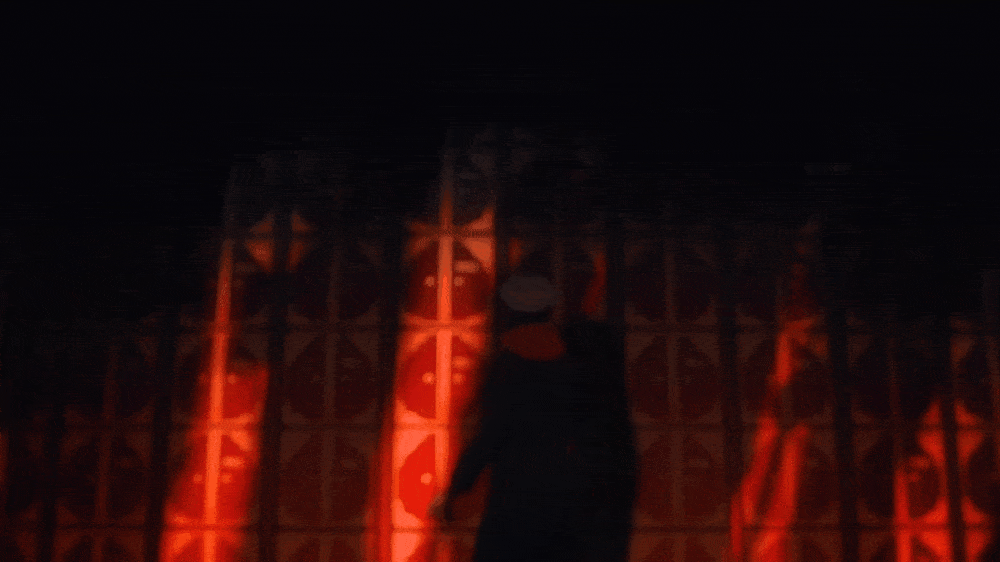
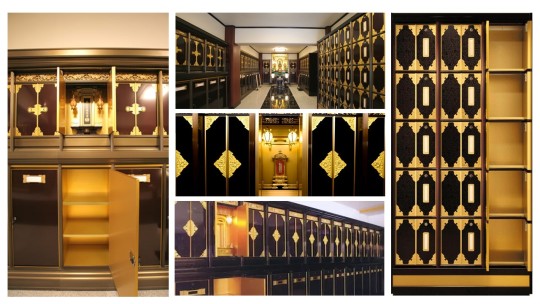
In this scene, Itadori is seen standing in front of a nokotsudo (納骨堂) which is a Japanese ossuary. A nokotsudo is known as a “nokotsuden” or “reido” and is a building in which the remains of cremation are kept. Nokotsudo are generally built in the precincts of temples and are equipped with lockers to keep the remains and are occasionally equipped with Buddhist altars above these lockers to place Buddhist mortuary tablets. This scene portrays Itadori breaking down in front of a nokotsudo. This could either refer to him facing the ashes of the people Sukuna killed using his body—or perhaps more improbably the scene depicts him being confronted with the fact that his grandfather's wish has inadvertently led him down this troubled path.
Joss paper (金紙)
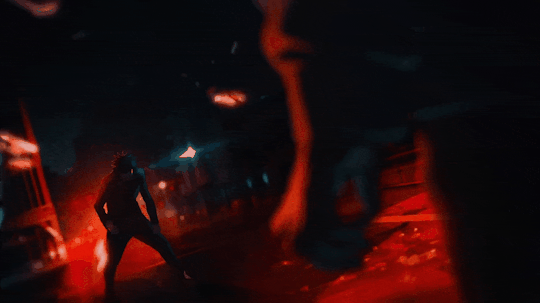
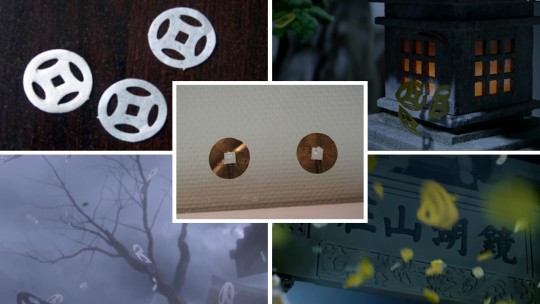
The rounded pieces of paper falling from the sky in this scene are likely pieces of joss paper (金紙). These are typically sheets of paper or papercrafts which are used as burnt offerings in ancestral worship as well as the veneration of deceased relatives on special holidays in Asia. Joss paper is typically printed with various representations of worldly goods such as money, houses, cars, credit cards, etc.… Joss paper is burnt at Asian funerals “to ensure that the deceased’s spirit has sufficient means in the afterlife”. In wuxia and xianxia C-dramas, joss paper is often seen falling from the scene during scenes in which the reanimated and ghostly beings invade the world of the living—which is somewhat similar to the setting in this scene with Megumi meeting his reanimated father. Additionally, it was partly Toji's pursuit of money that led to his death, taking him away from his son, so it is somewhat ironic to have joss paper raining down on him.
[P.S. A few people have been analysing this opening on other platforms, but I wanted to touch on some of the more obscure cultural nuances... I am not Japanese, so this is based off of my own research, so I apologise if I miss anything or get anything wrong. Feel free to make corrections or additions in the comments and reblogs respectively.]
#jujutsu kaisen#jjk#jjk season 2#jjk s2#anime#anime openings#anime opening#jjk op4#jjk opening 4#specialz#king gnu#jujutsu kaisen shibuya arc#yuji itadori#itadori yuji#itadori yuuji#itadori yūji#jjk itadori#yuuji itadori#megumi fushiguro#fushiguro megumi#jjk fushiguro#jjk megumi#jjk yuuji#jjk yuji
121 notes
·
View notes
Note
Hello! I was watching the Beijing Opera's Havoc in Heaven, and while I was admiring the beautiful stage makeup, I noticed that very distinct symbol on the Monkey King's forehead that looks like a swirly sunburst.
I was wondering if that symbol has any particular meaning, or if it's simply an aesthetic symbol that has come to be associated with the Monkey King through his opera makeup? I thought it might be neat to integrate it into my own design for Sun Wukong, but I'd rather not do so with a symbol I don't know the meaning and context of. I figured you'd be the best person to ask!

Chinese opera makeup is a big blind spot in my knowledge, so please take the following info as more of a suggestion than a fact.
A cursory search shows that some online sources refer to the flaming orb as a Fozhu (佛珠, "Buddha Jewel") and Shelizi (舍利子) or Sheli zhu (舍利珠, "��arīra"). I'm assuming that Fozhu is a variation of the latter two.
These pearl-like beads figure among the bodily relics left over from the historical Buddha’s cremation (fig. 1). Strong (2004) explains:
[They are the result] of a process of metamorphosis brought on not only by the fire of cremation but also by the perfections of the saint (in this case the Buddha) whose body they represent (p. 12).

I also imagine that there is a connection to the Ruyi baozhu (Ch: 如意寶珠, “as-you-will treasure jewel”; Sk: Cintāmaṇi, “wish-fulfilling jewel”). Also known as “Dragon jewels” (longzhu, 龍珠), these luminous orbs are commonly held by Bodhisattvas in Buddhist art (fig. 2), thereby signifying their ability to grant any wish that a believer desires (Buswell & Lopez, 2014, p. 193).
It wouldn't surprise me if Wukong was depicted with a holy, wish-granting treasure due to his great power and association with Buddhism.

Sources:
Buswell, R. E., & Lopez, D. S. (2014). The Princeton Dictionary of Buddhism. Princeton, NJ: Princeton University Press.
Strong, J. S. (2004). Relics of the Buddha. Princeton, NJ: Princeton University Press
#Sun Wukong#Monkey King#Journey to the West#JTTW#Chinese opera#Chinese opera makeup#Opera makeup#Buddhism#Lego Monkie Kid#LMK
108 notes
·
View notes
Note
I’ve been trying to look up information on Thai Buddhist funerals but all the English websites are vague or have little information. Do you have any information or websites you could recommend?
so obviously I'm not the authority on those, but I remember doing research on it back in the day + thai dramas are surprisingly realistic at portraying their culture, and even their funerals. funerals usually take either 3, 5 or 7 days. it has to be an odd day due to buddhist beliefs. there's is a water bathing ritual after death, and the body is then dressed and placed in a coffin in a temple where monks & the deceased loved ones will visit the deceased for the number of days they've chosen before the cremation. buddhist chants are of course involved, and the loved ones also pass cloth to the monks on behalf of the dead. usually a family gets a whole room for their loved one and stay with them and at least one person stays with them the whole day, greeting guests and taking care of them. finally, the body is cremated. all temples have a crematorium. some people can also actually wait 100 days after the death to cremate the deceased one (as can be seen in the lakorn chuamong tong mon.) the ashes are usually either stored in funeral chedis, which are small pointy towers present in all thai temples, or they can be stored in line around the temple if it has extra walls around it, where people will come to pray for their loved one. special merit-making also happens 7, 50 & 100 days after the person passed away. hope that helped!
xxx
29 notes
·
View notes
Text


Can a mound of dirt represent the Buddha, the path to Enlightenment, a mountain and the universe all at the same time? It can if it is a stupa. The stupa (“stupa” is Sanskrit for heap) is an important form of Buddhist architecture, though it predates Buddhism. It is generally considered to be a sepulchral monument—a place of burial or a receptacle for religious objects. At its simplest, a stupa is a dirt burial mound faced with stone. In Buddhism, the earliest stupas contained portions of the Buddha’s ashes, and as a result, the stupa began to be associated with the body of the Buddha. Adding the Buddha’s ashes to the mound of dirt activated it with the energy of the Buddha himself.
Early stupas
Before Buddhism, great teachers were buried in mounds. Some were cremated, but sometimes they were buried in a seated, meditative position. The mound of earth covered them up. Thus, the domed shape of the stupa came to represent a person seated in meditation much as the Buddha was when he achieved Enlightenment and knowledge of the Four Noble Truths. The base of the stupa represents his crossed legs as he sat in a meditative pose (called padmasana or the lotus position). The middle portion is the Buddha’s body and the top of the mound, where a pole rises from the apex surrounded by a small fence, represents his head. Before images of the human Buddha were created, reliefs often depicted practitioners demonstrating devotion to a stupa.
The ashes of the Buddha were buried in stupas built at locations associated with important events in the Buddha’s life including Lumbini (where he was born), Bodh Gaya (where he achieved Enlightenment), Deer Park at Sarnath (where he preached his first sermon sharing the Four Noble Truths (also called the dharma or the law), and Kushingara (where he died). The choice of these sites and others were based on both real and legendary events.
“Calm and glad"
According to legend, King Ashoka, who was the first king to embrace Buddhism (he ruled over most of the Indian subcontinent from c. 269 - 232 B.C.E.), created 84,000 stupas and divided the Buddha’s ashes among them all. While this is an exaggeration (and the stupas were built by Ashoka some 250 years after the Buddha’s death), it is clear that Ashoka was responsible for building many stupas all over northern India and the other territories under the Mauryan Dynasty in areas now known as Nepal, Pakistan, Bangladesh, and Afghanistan.
One of Ashoka's goals was to provide new converts with the tools to help with their new faith. In this, Ashoka was following the directions of the Buddha who, prior to his death (parinirvana), directed that stupas should be erected in places other than those associated with key moments of his life so that “the hearts of many shall be made calm and glad.” Ashoka also built stupas in regions where the people might have difficulty reaching the stupas that contained the Buddha’s ashes.
One of the most famous stupas, The Great Stupa (Mahastupa) was built at the birthplace of Ashoka’s wife, Devi, daughter of a local merchant in the village of Sanchi located on an important trade route in the state of Madya Pradesh, India
Karmic benefits
The practice of building stupas spread with the Buddhist doctrine to Nepal and Tibet, Bhutan, Thailand, Burma, China and even the United States where large Buddhist communities are centered. While stupas have changed in form over the years, their function remains essentially unchanged. Stupas remind the Buddhist practitioner of the Buddha and his teachings almost 2,500 years after his death.
For Buddhists, building stupas also has karmic benefits. Karma, a key component in both Hinduism and Buddhism, is the energy generated by a person’s actions and the ethical consequences of those actions. Karma affects a person’s next existence or re-birth. For example, in the Avadana Sutra ten merits of building a stupa are outlined. One states that if a practitioner builds a stupa he or she will not be reborn in a remote location and will not suffer from extreme poverty. As a result, a vast number of stupas dot the countryside in Tibet (where they are called chorten) and in Burma (chedi).
The journey to enlightenment
Buddhists visit stupas to perform rituals that help them to achieve one of the most important goals of Buddhism: to understand the Buddha’s teachings, known as the Four Noble Truths (also known as the dharma and the law) so when they die they cease to be caught up in samsara, the endless cycle of birth and death.
The Four Noble Truths:
1. life is suffering (suffering=rebirth)
2. the cause of suffering is desire
3. the cause of desire must be overcome
4. when desire is overcome, there is no more suffering (suffering=rebirth)
Once individuals come to fully understand The Four Noble Truths, they are able to achieve Enlightenment, or the complete knowledge of the dharma. In fact, Buddha means “the Enlightened One” and it is the knowledge that the Buddha gained on his way to achieving Enlightenment that Buddhist practitioners seek on their own journey toward Enlightenment.
The circle or wheel
One of the early sutras (a collection of sayings attributed to the Buddha forming a religious text) records that the Buddha gave specific directions regarding the appropriate method of honoring his remains (the Maha-parinibbāna sutra): his ashes were to be buried in a stupa at the crossing of the mythical four great roads (the four directions of space), the unmoving hub of the wheel, the place of Enlightenment.
If one thinks of the stupa as a circle or wheel, the unmoving center symbolizes Enlightenment. Likewise, the practitioner achieves stillness and peace when the Buddhist dharma is fully understood. Many stupas are placed on a square base, and the four sides represent the four directions, north, south, east and west. Each side often has a gate in the center, which allows the practitioner to enter from any side. The gates are called torana. Each gate also represents the four great life events of the Buddha: East (Buddha’s birth), South (Enlightenment), West (First Sermon where he preached his teachings or dharma), and North (Nirvana). The gates are turned at right angles to the axis mundi to indicate movement in the manner of the arms of a svastika, a directional symbol that, in Sanskrit, means “to be good” (“su” means good or auspicious and “asti” means to be). The torana are directional gates guiding the practitioner in the correct direction on the correct path to Enlightenment, the understanding of the Four Noble Truths.
A microcosm of the universe
At the top of stupa is a yasti, or spire, which symbolizes the axis mundi (a line through the earth’s center around which the universe is thought to revolve). The yasti is surrounded by a harmika, a gate or fence, and is topped by chattras (umbrella-like objects symbolizing royalty and protection).
The stupa makes visible something that is so large as to be unimaginable. The axis symbolizes the center of the cosmos partitioning the world into six directions: north, south, east, west, the nadir and the zenith. This central axis, the axis mundi, is echoed in the same axis that bisects the human body. In this manner, the human body also functions as a microcosm of the universe. The spinal column is the axis that bisects Mt. Meru (the sacred mountain at the center of the Buddhist world) and around which the world pivots. The aim of the practitioner is to climb the mountain of one’s own mind, ascending stage by stage through the planes of increasing levels of Enlightenment.
Circumambulation
The practitioner does not enter the stupa, it is a solid object. Instead, the practitioner circumambulates (walks around) it as a meditational practice focusing on the Buddha’s teachings. This movement suggests the endless cycle of rebirth (samsara) and the spokes of the Eightfold Path (eight guidelines that assist the practitioner) that leads to knowledge of the Four Noble Truths and into the center of the unmoving hub of the wheel, Enlightenment. This walking meditation at a stupa enables the practitioner to visualize Enlightenment as the movement from the perimeter of the stupa to the unmoving hub at the center marked by the yasti.
The practitioner can walk to circumambulate the stupa or move around it through a series of prostrations (a movement that brings the practitioner’s body down low to the ground in a position of submission). An energetic and circular movement around the stupa raises the body’s temperature. Practitioners do this to mimic the heat of the fire that cremated the Buddha's body, a process that burned away the bonds of self-hood and attachment to the mundane or ordinary world. Attachments to the earthly realm are considered obstacles in the path toward Enlightenment. Circumambulation is not veneration for the relics themselves—a distinction sometime lost on novice practitioners. The Buddha did not want to be revered as a god, but wanted his ashes in the stupas to serve as a reminder of the Four Noble Truths.
Votive Offerings
Votive Stupa, Bodhgaya, 8th century, stone, 78 x 44 x 35 cm (Ashmolean Museum, Oxford)
Small stupas can function as votive offerings (objects that serve as the focal point for acts of devotion). In order to gain merit, to improve one’s karma, individuals could sponsor the casting of a votive stupa. Indian and Tibetan stupas typically have inscriptions that state that the stupa was made “so that all beings may attain Enlightenment.” Votive stupas can be consecrated and used in home altars or utilized in monastic shrines. Since they are small, they can be easily transported; votive stupas, along with small statues of the Buddha and other Buddhist deities, were carried across Nepal, over the Himalayas and into Tibet, helping to spread Buddhist doctrine. Votive stupas are often carved from stone or caste in bronze. The bronze stupas can also serve as a reliquary and ashes of important teachers can be encased inside.
This stupa clearly shows the link between the form of the stupa and the body of the Buddha. The Buddha is represented at his moment of Enlightenment, when he received the knowledge of the Four Noble Truths (the dharma or law). He is making the earth touching gesture (bhumisparsamudra) and is seated in padmasan, the lotus position. He is seated in a gateway signifying a sacred space that recalls the gates on each side of monumental stupas.
Essay by Dr. Karen Shelby
#buddha#buddhist#buddhism#dharma#sangha#mahayana#zen#milarepa#tibetan buddhism#thich nhat hanh#stupa#amitaba buddha#dewachen#sukhavati#enlightenment spiritualawakening reincarnation tibetan siddhi yoga naga buddha
9 notes
·
View notes
Text
In the Vampire Yukierre AU, discussions between @yuki-shipnoda and I went to some fun rabbit holes.
More specifically how would a Japanese vampire arise given the amalgamation of Shinto, Buddhist and Confucian beliefs.
What we've come up with is that the Japanese vampire or known colloquially as the kyuuketsuki isn't made with a typical bite from another vampire.
Kyuuketsuki are born when a dead body doesn't receive the proper purification rites before they are interred or aren't cremated (though a few kyuuketsuki were powerful enough to reassemble their bodies from the ashes and bone fragments). If the person met a sudden and brutal end, they are more likely to end up a kyuuketsuki.
They would have the shapeshifting powers, enhanced senses,an immense healing factor (if provided with enough blood) and would retain animal like behaviors in their human forms and kyuuketsuki are the only beings that illusion magic from other yokai such as kitsune and tanuki will not work on. They can also walk in direct daylight (as a direct middle finger to Amaterasu), in stark comparison to their Western counterparts.
Kyuuketsuki prefer the forms of birds rather than the typical wolves, bats and rats of Western vampires, finding them more useful with feigned frailty and innocence to lure their prey. Songbirds are the most common form for kyuuketsuki to take, though larger birds like crows and ravens, parrots, and even birds of prey are noted but uncommon. Their scent can even mimic the animals they shift into and often fool typical animal populations to more easily blend in.
But they do share some weaknesses with the Western vampire: holy water from a Shinto priest/miko, blessed salt used in Shinto purification rituals, Shinto/Buddhist prayers, they are unable to enter holy spaces, must be invited into buildings, silver can be used against them (vintage photography (Ex. Polaroids) will not show kyuuketsuki/vampires, old mirrors backed with silver will not show their reflections, and direct contact with silver burns and repels them).
Kyuuketsuki also have subtle tells that children are more likely to pick up on: their fangs will be seen in smiles both small and big, their laughter would be closer to their preferred animal form call rather than a human laugh, cool pallid skin , sharp nails that resemble talons, eyes that flicker red in both human and animal forms and upon scenting blood.
Japanese vampires can also intake both human blood and animal blood to satiate their neverending thirst. They use both animal and human forms depending on which prey their animal form prefers though larger prey can be hunted with groups of kyuuketsuki. Blood is the only thing a kyuuketsuki is filled due to the degenerated organs in their body, but other fluids like alcohol or tea can also be drunk to better keep up the facade of being human.
#f1#f1 rpf#vampire au#vampire yukierre au#yukierre#yuki tsunoda#pierre gasly#yt22#pg10#it makes one think#what if some desperate family was willing to forgo the usual purification rites#for a dead family member#out of fear and#and soon regretted their actions#and had to purify their now undead family member and properly send them off#kyuuketsuki#worldbuilding
8 notes
·
View notes
Text

Over ten years ago, one of my disciples in Vietnam had a stupa - a Buddhist shrine - built for my ashes. I told her that I didn’t need a stupa for my ashes. I don’t want to be stuck in a stupa. I want to be everywhere.
“But," she protested, “it’s already built!"
“In that case," I said, “you’ll have to put an inscription on the front, saying, ‘I am not in here.’" It’s true. I won’t be there in the stupa. Even if my body is cremated and the ashes are put in there, they aren’t me. I won’t be in there. Why would I want to be in there when outside it is so beautiful?
But in case some people misunderstand, I told her they might need to add another inscription, saying, “I am not out there either." People won’t find me inside or outside the stupa. Yet they may still misunderstand. So there may need to be a third inscription that reads, “If I am to be found anywhere, it is in your peaceful way of breathing and walking." That is my continuation. Even though we may never have met in person, if, when you breathe in, you find peace in your breathing, I am there with you.
- Thich Nhat Hanh, in “The Art of Living".
46 notes
·
View notes